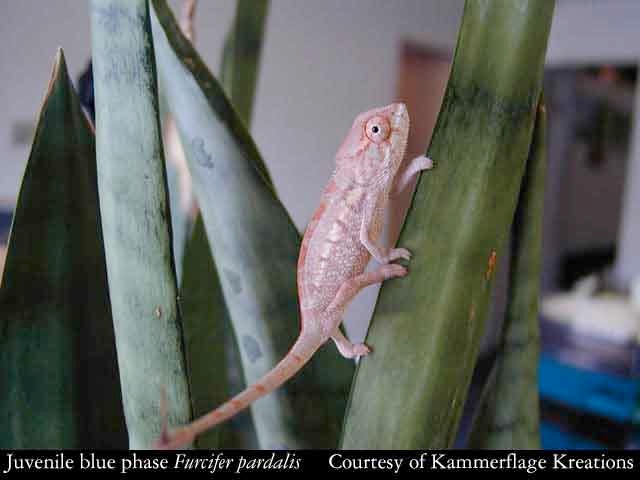



Furcifer pardalis - Selecting a Baby Blue Panther
By Bill Strand
Citation:
Strand, B. (2002). Furcifer pardalis - Selecting a Baby Blue Panther. Chameleons! Online E-Zine, March 2002. (http://www.chameleonnews.com/02MarStrandBabyBlues.html)
Furcifer pardalis - Selecting a Baby Blue Panther
Introduction:
Should you decide to buy a baby Blue Panther you may have the option of personally selecting a baby from the clutch. It is an exciting day and you do not realize the significance of the moment until you are faced with twenty bug-eyed babies scrambling over each other. The breeder just leans back and lets you take in the grandeur. You didn't realize how hard it would be to choose! Here is an introduction on how to select a baby chameleon. I will customize the approach for Blue Panthers, but the steps are very much the same with any species of chameleon. Each image link to the right will link you to a full size image and a brief description of the useful information each photo holds.
First Things First:
The first decision one should make would be the appropriate age of a chameleon that matches their experience level. Most reputable breeders will not sell their panthers until three months of age. As babies hatch at different sizes and grow at different rates the three month "rule" is not a hard line. It comes about because most panthers are to the size that they are stable at three months. This usually corresponds to about 1 inch (2.54 cm) Snout to Vent Length (SVL). SVL is a measurement from the nose to the beginning of the tail base. One inch (SVL) is the size that someone with basic chameleon experience may expect to successfully raise the baby. Keepers with more experience can take the babies earlier while those with less confidence may choose to take an older specimen. The larger the chameleon the fewer the problems that will arise in raising it.
Health:
Health is the number one consideration when choosing your future pet. If the baby you're considering does not appear vigorous and active you should hold off on your purchase. Here is what to look for:
1) Eyes. A chameleon's eyes are the best single gauge of a chameleon's health. The eye turrets should be full and bulging. During the day, the eyes should be open and alert with the chameleon constantly surveying its surroundings. Sunken eye turrets or closed eyes indicate a problem. If a chameleon is overstressed, dehydrated, or not feeling well the first place you will see this will be in the eyes.
2) Walking the walk: If a chameleon does not run with vigor and strength then you have reason to chose another. Of course, the animals body temperature will effect its activity level.
3) Walking tall: Be sure that the chameleon can easily hold itself up off the branch with it's legs. A common problem in chameleons raised indoors is Metabolic Bone Disease (MBD). This is a lack of calcium in the bones and can be identified if the chameleon's bones seem soft. A good way to test for this is to just observe your potential new chameleon walk. Be sure the chameleon can hold its body above the branch and has a quick, strong gait.
4) Eating: Though not always possible it is always a nice thing to observe your potential chameleon eating. This shows you that its tongue and mouth are in working order. MBD will also manifest itself in rubbery jawbones that may later harden in a misshapen jaw line making it difficult to eat or keep their mouth closed. Although other problems here are rare, any problem with the eating mechanism of a chameleon is serious.
Sexing:
The sex of the chameleon may play an important part in your selection. Whether in ornamentation, size, color, or personality, most chameleons available to the hobbyist have noticeable differences between male and female. It then follows that you may be selective as to which sex you want. Each species has it's own sexual differences with some being more obvious than others. In the case of blue panthers you probably are looking for males for color or females for breeding. Thus a paragraph of determining sex in young panthers is warranted. The bad news is that there are only clues and few of them are definitive.
1) Color: You may be able to guess at the sex by color, but this is hardly a 100% guarantee. Some clutches are very helpful and after a couple of weeks all the males will be a bluish grey while the females will hold a pleasant orange or tan color. Unfortunately, some of the orange/tan animals may turn out to be males. Some clutches come out with the males and females all being that pleasant orange/tan color. In this case other characteristics must be looked at. Older Panther Chameleon females tend toward the orange/tan color and males gravitate towards the bluish grey range. This still is not definitive as some captive bred females seem to be covered in sky blue spots and could fool you into thinking they will be spectacular males when they fully mature.
2) Hemipenal bulge: The most definitive way of determining sex is the presence of a hemipenal bulge. This bulge at the base of the tail is an indication of a male. Male Panthers develop this bulge at different ages so the absence of the bulge is not a definite sign of a female.
Color:
Color is usually the reason why a Blue Panther is chosen out of all the chameleons. The bottom line is that you cannot tell what color the adult will hold from the juvenile colors. It is easy to see blue colors starting in at an early age and predict that he will be spectacular as an adult. But babies with a high amount of blue have turned aqua and babies with mostly orange have turned stunning blue. Add to this mix the fact that the aqua Panther may all of a sudden surprise you and be sky blue for a couple of months and the stunning blue may surprise you and decide to "color down" for a couple of months. The best you can do is get the best genetic mix possible. Then enjoy your Panther through all the color changes he will go through over his life!

This picture was taken an hour after this baby crawled out of it's egg. Pieces of vermiculite are still stuck to it's skin in places. At this age neither sex nor adult color are able to be determined.

This hatchling would not yet be sold, but it is showing the alert look you should search for when selecting a baby chameleon. This specimen is a female and is about 2 months old.

This female has reached the size appropriate for going to a home of keepers with basic chameleon experience. She is demonstrating the strength and confidence in her walk that shows that she is healthy. This specimen is about three months old.

This male is beginning to show some very nice blue coloration. Note the grey color that identifies a male. This male is about four months old.

This older male is filling in his blue color. This male is about five months old.

This female is six or seven months old.

A six month old male blue panther. Many times the blue coloration will come in patches such as seen on the flank of this specimen.

At 9 months, this sub-adult panther is coming into his adult coloration

Bill Strand

Bill Strand currently works in the area of exotic animal breeding and continues to refine husbandry techniques with a broad range of chameleon species. A special interest of his is the creation of captive environments. He was the Assistant Editor and Webmaster of this Chameleons! E-Zine from March 2002-March 2004.









Join Our Facebook Page for Updates on New Issues:
© 2002-2014 Chameleonnews.com All rights reserved.
Reproduction in whole or part expressly forbidden without permission from the publisher. For permission, please contact the editor at editor@chameleonnews.com
